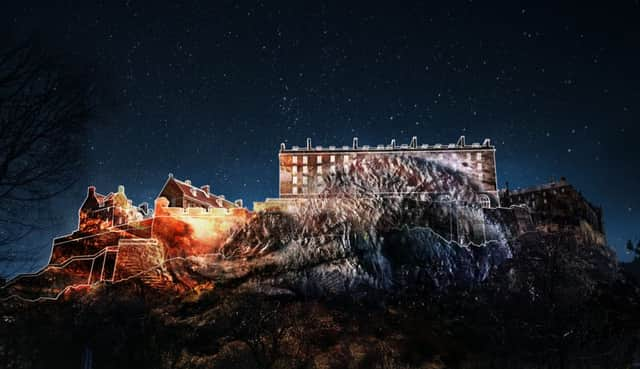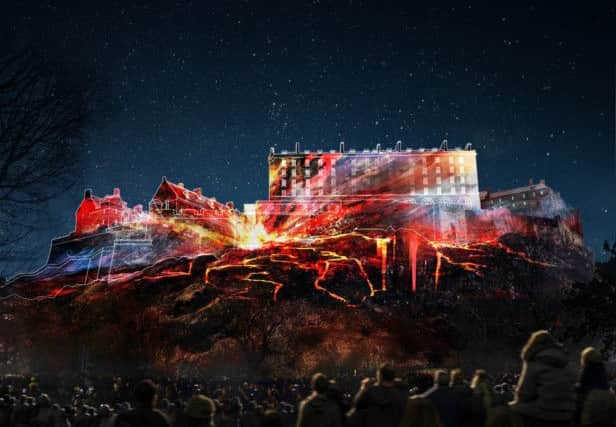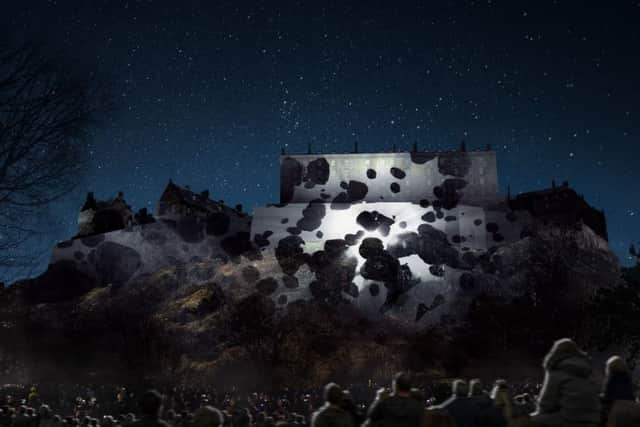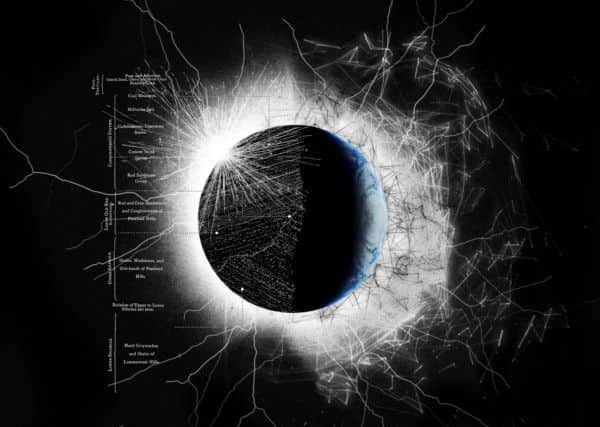Deep Time will light up the Castle in a unique performance


“We drove around Edinburgh in the dead of night and had those half logistical, half creative conversations, about what we wanted to do, where and why,” Warner says. “We were looking at bits of the city in the dark.”
The two men had begun to plan a follow-up to the Harmonium Project, the unforgettable free spectacle Warner’s company produced to launch the 2015 festival. With the music of John Adams, the sound of the Edinburgh Festival Chorus, and pin-point light effects, it turned the outside skin of the Usher Hall alive, a moving, living thing.
Advertisement
Hide AdAdvertisement
Hide Ad“We cast the net very wide,” said Warner, “but in so far as we wanted to make this really about the city in quite a broad way, rather than specifically one feature of it, that rock and that castle is absolutely the iconic face of Edinburgh, and it seemed a little wilful to ignore that.” After funding came through, the Standard Life Opening Event: Deep Time was the result.


Warner and his partners founded 59 Productions in Edinburgh, where his flat looked out on Arthur’s Seat. This year’s concept grew to embrace the city’s startling geology, and specifically the figure of James Hutton, an 18th entury luminary of the Scottish Enlightenment, lesser known than John Hume or Adam Smith but regarded as the father of geological time.
I got lucky with Harmonium; walking down Lothian Road as the barriers were going up, I stayed on at the front of a growing crowd. We watched as the gray lady of the hall was transformed – with the effects pulling living faces out of the stone, then seeming to lift the building up and fly it across a sweeping panorama of Edinburgh, ending with jets of lights through smoke making a funnel into the sky. At the time I and not a few around rated it the best thing we’d seen in Edinburgh.
Expectations will be higher for the follow-up. With Deep Time, “we are not celebrating a moment in history or Hutton’s place in history,” says Warner. “We are celebrating the history of Edinburgh over 350 million years which is a wildly epic and ambitious thing to do.”


From its Edinburgh beginnings in the early 2000s, founded by graduates Warner and Mark Grimmer, 59 Productions delivered early pieces that included video designs for the National Theatre of Scotland’s Roam and Black Watch It is now a London-based, Tony award-winning company with a global operation that has reached from the Sydney Opera House to the London Olympics opening ceremony.
Those of us who have lived in Edinburgh long enough sometimes wonder what would happen if the rock, formed as a volcanic plug in the vent of a volcano, exploded once again. For their own eruption, 59 Productions will use more than 40 projectors and a wall of sound from Scottish band Mogwai, with a free but ticketed audience of 28,000 people for an 18-minute account of the history of time.
Linehan’s decision to open his festival with a flagship free spectacle has won warm praise (it will still end with the fireworks concert). Nica Burns, the London theatre owner and veteran Edinburgh comedy boss, calls it the kind of unique programming Edinburgh’s festivals need in a sea of international competition. “It’s a brilliant change and I think it’s going to be something that people look forward to every year,” she says.
Advertisement
Hide AdAdvertisement
Hide AdDeep Time is not a curtain-raiser for festival work, but a stand-alone artwork in its own right. It uses the west facade of the castle, and the rock beneath it, a different aspect from the fireworks concert. The western end is darker and more imposing, in Warner’s view, and road closures easier. The City Council will dim the street lights. The work matches Linehan’s contemporary music strand; while Deep Time brings four existing Mogwai tracks together, the band are also performing new work with the film-maker Mark Cousins for Atomic, marking the 70th anniversary of Hiroshima.


Late last month 59 Production’s engineers were using jumbo jets at Boeing’s headquarters in Seattle as a moving canvas for that company’s centenary celebrations. YouTube footage shows the skin of a 747 seemingly peeled away, the illusion of the aircraft being loaded, the passengers settling into their cabins; then a plane takes off within a plane. Warner describes the company’s work as storytelling, using technology and art.
For Deep Time they will use 20,000 square metres of the stationary but very challenging surface of castle and rock, from innumerable scars and crags to changing foliage. “It was about discovering what the rock did to the work and how it could become a participant, a performer in the piece,” said Warner. “Once we’d chosen that site, it became almost immediately, simultaneously evident that it had to be about that place and about that physical phenomenon.”
Preparations included mapping with laser scans, satellite, aerial, and hundreds of on-site photographs. The resulting 3D print of the castle, a light model roughly a metre square, has been traveling up and down to Edinburgh by rail and plane lately, used for miniature test projections. “You can put your head roughly in the audience position, get a real sense of how that physical surface interacts with the images,” Warner says.


James Hutton qualified in medicine from the University of Edinburgh; he became a prosperous landowner whose writing ranged to agriculture and philosophy, but also transformed thinking on the formation of the Earth’s crust. He took to geology in middle age, and began with the observations of the rocks of different kinds intersected and piled on top of one another at wild angles. He studied Salisbury Crags, but it was the “unconformities” he observed, particularly the stunning Siccar Point, at Dunbar, where he took to a boat, that shaped his ideas.
Biblical scholars suggested the Earth might by 6,000 years old: Hutton concluded from rocks that the Earth was “locked in an eternal cycle of erosion and uplift,” from its internal heat, as Bill Jenkins of the University of Edinburgh observes (the university’s scholars advised on the project). Hutton’s Theory of the Earth, published in 1788 to (at first) little notice, suggested that time “stretched immeasurably behind and ahead of humanity”, as Jenkins puts it, in the concept called deep time.
There will be volcanoes, and there will be dinosaurs, in this Deep Time. There will be the “lost drawings” by James Clerk, made on the spot during Hutton’s observations but not published for 200 years. And there will be photographs of Hutton and fellow Edinburgh luminaries, along with snaps submitted by Edinburgh residents, in a photo montage. The team use Hutton’s travels – he made important early observations in Glen Tilt, in the south-west, and in Arran – to fill out its long view of Edinburgh and Scotland.
Advertisement
Hide AdAdvertisement
Hide AdWarner graduated from York University, but describes Edinburgh as his artistic and spiritual home. He has clearly thought carefully around Hutton’s ideas – even if the rock itself is not the location most noted in his theories. “His explosion of Biblical time into deep time, into geological time, is an extraordinary thing because without that you don’t have Darwin, you don’t have the theory of biological evolution because you simply don’t have enough years for it to take place, intellectually speaking.” He is fascinated that when rock was formed, “Edinburgh was on the equator and underwater, that’s an extraordinary pair of facts which we have kind of fixated on in the show, celebrating that the world is fluid.”
Some 45 projectors on the top of the Saltire Court building, which houses the Traverse Theatre, will take aim from more than 100 metres away. Aside from managing the crowds, the only only other potential problem s Edinburgh’s most famous weather phenomenon. “The one thing which is a nightmare situation is the fog, or the haar,” said Leo. “Very dense atmospheric water vapour in the air, that is problematic, there’s nothing we can do about it. Rain will affect us because the distances are very big, but we’ve done rain before, it does something really interesting to the whole experience, in a way it’s much more magical, strangely.” The music is not live but the performance will be tweaked to the last minute; sound engineers will be adjusting for the acoustic effects of the crowd itself.
“Mogwai have this epic sound, it’s very loud, very tectonic,” says Warner. “It’s very Scottish in a way that is not very obvious but deeply embedded. Although they play rock instruments pretty hard and pretty loud, their music is very orchestral and about layers of sound and chromatic progressions, they are longer than your average rock song.”


While the work uses some of Mogwai’s “delicate stuff”, he was drawn to the music’s “glacial movement”. “Are we going to tone it down? No we are not. I want people to feel at the very least they have experienced an earthquake, if not more.”
Deep Time, tomorrow, 10:30pm.
